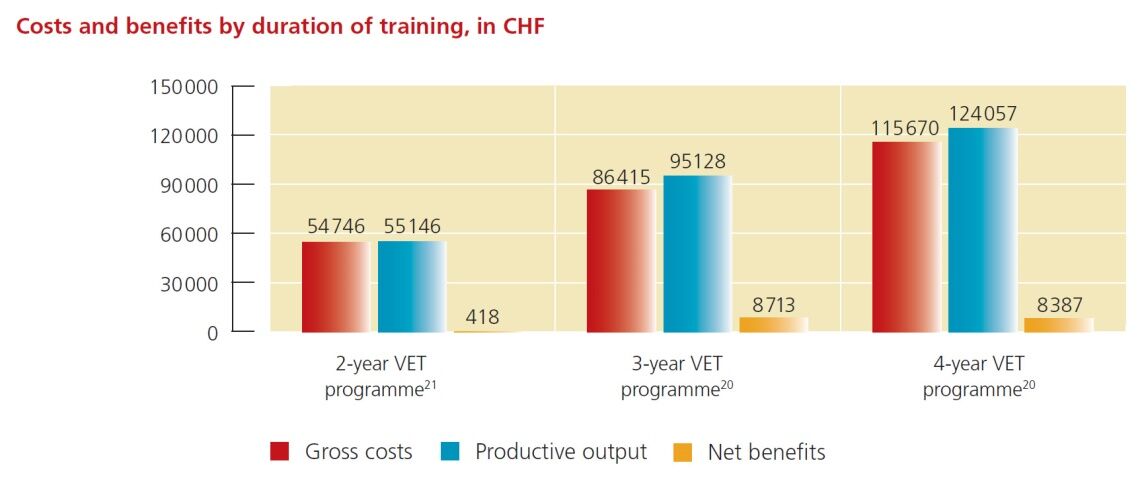Company Costs and Benefits in Switzerland
In Switzerland, the private sector contributes substantially to the financing of the VPET system. Companies for example bear the costs the salaries of the apprentices and their trainers. After all, they are motivated to do this, as profit economically. There is a positive correlation that leads to a net benefit for the company conducting an apprenticeship. Extensive research on the cost-benefit ratio of apprenticeships shows that companies offering apprenticeship-positions retrieve a net benefit.
Costs and benefits of apprenticeship
For each apprenticeship in the different sectors, the cost-calculations are different. The gross cost of an apprenticeship position for a company is between CHF 20,000 and CHF 30,000 per year. Some apprenticeships are more expensive than others. Opposite to the gross cost of an apprenticeship position for a company, there is the average productive performance of an apprentice, which is between CHF 18,000 and CHF 36,000 per year. One factor of the gross cost is the apprenticeship salary, which is relatively low for Swiss apprentices in comparison with the ones in some EU member states. Roughly speaking, an apprentice in Switzerland earns about 12% of a typical salary for a given occupation in the first year of his/her apprenticeship.
Swiss studies on cost-benefit-ratio for companies
A study conducted by Strupler and Wolter (2012) in 2009 analysed apprenticeship salaries. They showed the example of learners enrolled in a three-year VET programme in industrial painting; during the 1st year, the apprentice painter earns a gross annual salary of CHF 8,768 (~ EUR 8,000); in the 2nd year, CHF 11,566 (~ EUR 10,600); and in the 3rd year, the apprentices will receive CHF 18,534 (~ EUR 17,000). In total, the apprentice painter will have earned CHF 38,868 during his three-year apprenticeship from the host company, which includes 12 times a monthly salary, 13th/14th month salary, special provisions and additional expenses. The study is a good indication of most VET programmes and the range of the salary from the lowest (about 30’000 CHF (~ EUR 27,000)) to the highest (about 68’000 CHF (~ EUR 62,000)) is quite large.
On average, host companies stand to benefit from taking part in VET programmes. According to the cost/benefit study from Strupler and Wolter (2012), gross costs of involvement in VET amounted to CHF 5.3 billion (~EUR 4.9 billion). This figure was outweighed by the productive output generated by apprentices, which amounted to CHF 5.8 billion (~EUR 5.3 billion). Hence, the result is a net gain of CHF 0.5 billion (~EUR 0.4 billion).

Furthermore, as Fuhrer and Schweri (2010) could show the net benefit varies with the duration of a VET-programme. Analysis revealed that three-year programmes that usually are less demanding or complex than four-year programmes allow for the largest net-benefit in comparison with the others. However even in less demanding tow-year programmes that are design for apprentices with mainly practical talents or apprentices, that might have some learning difficulties a net-benefit can be achieved from companies.

These findings has been confirmed by a more recent study (Gehret et al., 2019)
In addition, with the help of cost-benefit analysis, it was possible to prove that private rates of return on education also for Swiss PE qualifications (professional college degrees and qualifications issued to those passing professional examinations) and higher education qualifications all show positive net benefits for the individual. However, the individual net benefits of an additional year of PE outweigh the net benefits of an additional year spent at a higher education institution. This means that the private costs of pursuing a PE qualification are usually compensated by average income gains of 16-25%. These figures show how well tertiary-level education is developed for individuals who start with a VET programme at upper-secondary level and later decide to obtain a PE qualification.
Cost-Benefit Analysis Tool
The cost-benefit ratio always depends on national features like wage structures, labour market regulations, the education system, etc. It is therefore unlikely that Swiss results can be applied directly to other contexts outside of Switzerland. However, Swiss researchers (Schweri 2014) at SFIVET have been working on a tool for Cost-Benefit Analysis (CBA), which also enables ‘ex ante simulation’. With those simulations, it is possible to analyse education systems in countries where apprenticeship training systems have not yet been introduced. The CBA-tool was designed to collect data and show simulations of the effect of changes in occupational curricula (reforms) in real time.
- Gehret, A., Aepli, M., Kuhn, A. & Schweri, J. (2019). Lohnt sich die Lehrlingsausbildung für die Betriebe? Resultate der vierten Kosten-Nutzen-Erhebung. Zollikofen: Eidgenössisches Hochschulinstitut für Berufsbildung EHB.
- Vocational and Professional Education and Training in Switzerland. Facts and Figures 2019
- Wolter, C. & Mühlemann S. (2014), Return on Investement of Apprenticeship Systems for Enterprises: Evidence from Cost-Benefit Analyses. IZA Journal of Labour Policy, 3(25).
- Schweri, J. (2014): Cost-Benefit Analysis and Tools – the Swiss experience. Swiss Federal Institute for Vocational Education and Training (SFIVET)
- Strupler, M. & Wolter, S., C. (2012): Dual-track VET: a success story – also for host companies. Results of the third cost-benefit analysis of apprenticeship training from the firm's perspective. Rüegger Verlag (Zürich und Chur).. (in German)
- Cattaneo, M. (2011): New Estimation of Returns to Higher Professional Education and Training. Empirical Research in Vocational Education and Training, 3(2), p. 71-84
- Cattaneo, M. & Wolter, S. (2011). Der individuelle Ertrag einer höheren Berufsbildung. Die Volkswirtschaft. Das Magazin für Wirtschaftspolitik 12(1), pp. 63-66. (in German and French)
- Fuhrer M. & Schweri J. (2010): Two-year apprenticeships for young people with learning difficulties: a cost-benefit analysis for training firms. Empirical Research in Vocational Education and Training, Vol. 2(2) 2010, 107-125.